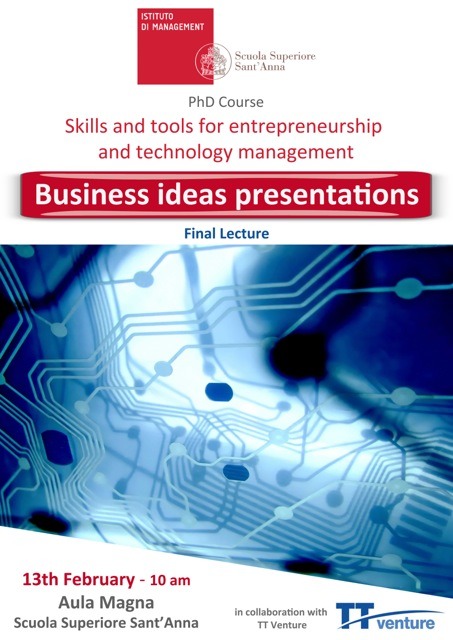In this course we discuss theories and methods to help PhD students to see the technologies they are working with everyday with a new pair of glasses. It is like they are choosing the red pill and follow the rabbit down the hole!!
I remember last year’s panik of one of the students, after the first session and the first assignments “these papers that you have given us… I don’t understand them.. where is the model? where is the equation? it is mostly blah blah…”
Short description of the course:
The course is designed to introduce all Scuola Superiore Sant’Anna PhD students (i.e. both social and experimental scientists) to the fundamental skills and tools regarding technology management in general and high-tech entrepreneurship. In particular, both management and S&T students are invited to participate, as well as students from Laws and Political Science. This will allow a multidisciplinary approach. Management students will benefit from knowing the scientific literature and from interaction with their S&T colleagues who will bring real experiences. S&T students are expected to enhance their skills and learn new tools that will be useful for their research and/or managerial and/or entrepreneurial careers. The course will include some “traditional” one-way teaching but will be mostly based on students’ presentations and case study analysis.
Some external speakers (entrepreneurs, managers, consultants, etc.) will be also invited.
Schedule, topics, descriptions, readings
The course is divided into two parts. During the first five classes we will explore relevant theories from business studies that are useful to improve our skills on innovation management and entrepreneurship. Discussion of these theories will be extremely applied; relevant experience of S&T students will be key to exemplify concepts that we will explore in class.
After the Christmas break, we will provide relevant practical tools that are going to be useful to apply on the field.
The course will take place on Wednesday from 10 am to 1 pm, in Room 3
at Polo Sant’Anna Valdera, (Viale Rinaldo Piaggio, 34) in Pontedera, with the following calendar.
| Date | Topic | Required Readings | Hours |
| Nov 14, 2012
|
Introduction to innovation management
Guest speaker: Nicola Redi, TT Venture |
3 | |
| Nov 21, 2012 | Open Innovation & open business models |
Di Minin, A., F. Frattini, and A. Piccaluga. 2010. Fiat: Open Innovation in a Downturn (1993-2003). California Management Review, 52(3): 132-59. (Group 1 summarizes and Group 2 exemplifies)
Chesbrough, H.W. 2007. Why companies should have open business models. Mit Sloan Management Review, 48(2): 22-28. (Group 3 summarizes and Group 4 exemplifies) |
3 |
| Nov 28, 2012
|
University-industry collaborations: why and how | Etzkowitz, H. 1997. Innovation in innovation: the Triple Helix of university-industry.-government relations. Social Science Information, 42(3): 293-337.
(Group 5 summarizes and Group 6 exemplifies)
Kenney, M., Patton, D. 2009. Reconsidering the Bayh-Dole Act and the Current University Invention Ownership Model. Research Policy, 38(9): 1407–1422. (Group 7 summarizes and Group 8 exemplifies) |
3 |
| Dec 5, 2012
|
High-tech marketing
|
Christensen, C.M., and M. Overdorf. 2000. Meeting the challenge of disruptive change. Harvard Business Review, 78(2): 66-78. (Group 2 summarizes and Group 1 exemplifies)
Slater, S., Mohr, J.J. 2006. Successful Development and Commercialization of Technological Innovation: Insights Based on Strategy Type. The Journal of Product Innovation Management, 23(1): 26-33. (Group 4 summarizes and Group 3 exemplifies) |
3 |
| Dec 12, 2012
|
Commodity trap and service based business models | Chesbrough, H. The Case for Open Services Innovation: the commodity trap. California Management Review, 53(3): 5-20.
(Group 6 summarizes and Group 5 exemplifies) Gawer, A., and M.A. Cusumano. 2008. How companies become platform leaders. Mit Sloan Management Review, 49(2): 28-35. (Group 8 summarizes and Group 7 exemplifies) |
3 |
| Jan 16, 2013 | IP Management
Guest speaker Ing. Marco Celestino, ABM Pisa |
Yoffie, D.B. 2005. Intellectual Property and Strategy. Harvard Business School, 2005 (April 7). (only one short presentation by Group 1 )
Oliver Alexy, P.C., Ammon Salter. 2009. Does IP strategy have to cripple Open Innovation? Mit Sloan Management Review(Fall): 71-77. |
3 |
| Jan 23, 2013 | Business planning
Guest Speaker: Dott. Matteo Faggini, TT Advisor |
3 | |
| Jan 30, 2013 | Entrepreneurship
Guest Speakers Alessandro Fusacchia Matteo Piovanelli, SEM+ |
Clayton Christensen’s talk at the WEF in Davos 2013 (only one short presentation by Group 2)
letter to the shareholders written by Mark Zuckerberg before the Facebook IPO |
3 |
| Feb 6,
2013 |
Newcos: administration and taxes
Guest Speaker: Giuseppe Iannone Studio Della Santina |
No Readings Assigned | 3 |
| Feb 13, 2013 | Presenting your ideas to finance people
Guest speaker Ing. Nicola Redi (TT Venture) |
Groups’ presentations. | 3 |
Student commitment
Upon enrolling into this course, students commit to come to class prepared to comment on the required readings. During the first lecture students will be divided into study groups, which will deliver in-class presentations. Attendance is compulsory.
Final Examination
A final take-home exam will take place at the end of the course. Further details about the exam will be given at the beginning of the course.
As in these days when you talk about start-ups, high-tech entrepreneurship, etc etc , you get so much attention… we got even a quite nice press coverage.
Check it out:
